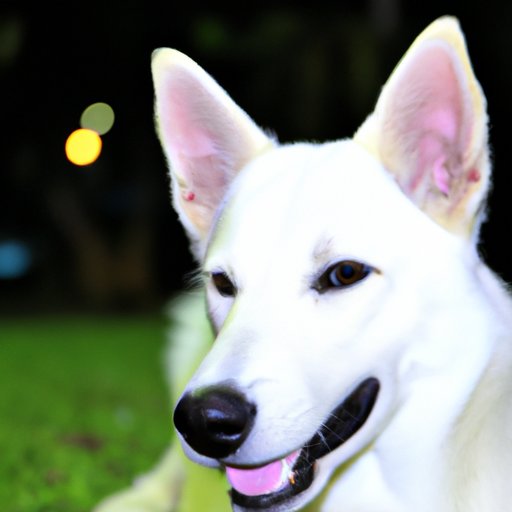Introduction
Dogs are known for their incredible senses. They have an extraordinary sense of smell and hearing, but how well can they see in the dark? Dogs are able to see better than humans in dim light, but their vision is not as sharp as our own. In this article, we will explore the different aspects of canine night vision, from the anatomy and adaptations of a dog’s eye, to the impact of breed on canine night vision, to the various behaviors associated with canine night vision, and finally, ways to improve the night vision of your dog.
Comparing the Night Vision of Dogs to Other Animals
The ability to see in the dark is a trait shared by many animals. Humans, for example, can see in low light, but not nearly as well as some animals. Nocturnal animals like cats, owls, and bats are particularly adept at seeing in the dark, thanks to their large eyes and specialized rods and cones in their retinas. Dogs also have larger eyes than humans, but their night vision isn’t quite up to par with that of cats, owls, and bats.
The differences in night vision between dogs and other animals can be attributed to several factors. For one, dogs lack the specialized rods and cones found in the retinas of nocturnal animals. These rods and cones enable animals to see in low light environments by absorbing more light than regular cells. Additionally, dogs have less of these light-sensitive cells than other animals, which further reduces their ability to see in the dark.
Examining the Anatomy of a Dog’s Eye
To better understand canine night vision, it’s important to look at the structure of the eye itself. A dog’s eye is similar to a human eye in many ways. It contains the same basic components: the cornea, iris, lens, retina, and optic nerve. However, there are some key differences that affect a dog’s night vision.
For starters, dogs possess a tapetum lucidum, a reflective layer located behind the retina. This layer reflects light back into the eye, allowing dogs to capture more light than humans can. Additionally, dogs have a much larger field of view than humans, which helps them detect movement in low light environments.
Finally, dogs possess a higher concentration of rods than humans. Rods are light-sensitive cells that allow animals to see in low light conditions. This gives dogs an edge over humans when it comes to seeing in the dark.

Investigating the Impact of Breed on Canine Night Vision
The size and shape of the eye can also play a role in how well a dog can see in the dark. Smaller eyes tend to have poorer night vision than larger eyes, as smaller pupils let in less light. Additionally, eyes with a rounder shape are better suited for night vision than those with a more elongated shape.
The color of the eye can also affect night vision. While most dogs have brown eyes, some breeds such as huskies and Malamutes have blue eyes. Studies have shown that blue eyes absorb less light than brown eyes, resulting in poorer night vision.

Analyzing the Various Behaviors Associated with Canine Night Vision
So what can a dog do with its enhanced night vision? Dogs have a variety of behaviors associated with their night vision, from navigating obstacles in low light to interacting with humans in the dark. For example, dogs are able to pick up on subtle cues from their owners in low light environments, such as hand signals or vocal commands.
Additionally, dogs are able to detect obstacles in the dark and adjust their movements accordingly. This allows them to navigate around objects and find their way in unfamiliar environments. Finally, dogs are able to detect prey in the dark, making them effective hunters even when light is scarce.

Discussing Ways to Improve the Night Vision of Your Dog
There are several ways to help improve the night vision of your dog. The first is proper nutrition. Providing your dog with a balanced diet full of vitamins and minerals can help support healthy eye function. Exercise and stimulation are also important. Playing games and going for walks can help keep your dog’s eyes active and alert.
Finally, it’s important to pay attention to your dog’s eye health. Regular visits to the vet can help detect any potential issues early on, and certain supplements can be used to boost the health of the eyes. By taking these steps, you can help ensure your dog’s night vision is as sharp as possible.
Conclusion
In conclusion, dogs have a heightened sense of night vision compared to humans. This is due to their larger eyes, reflective layers, and higher concentrations of rods. Additionally, the size and shape of the eye, as well as the color of the eye, can all play a role in how well a dog can see in the dark. Dogs are able to use their night vision for a variety of behaviors, from navigating obstacles in low light to detecting prey in the dark. Finally, there are several ways to help improve the night vision of your dog, such as proper nutrition, exercise and stimulation, and eye health care.
(Note: Is this article not meeting your expectations? Do you have knowledge or insights to share? Unlock new opportunities and expand your reach by joining our authors team. Click Registration to join us and share your expertise with our readers.)
